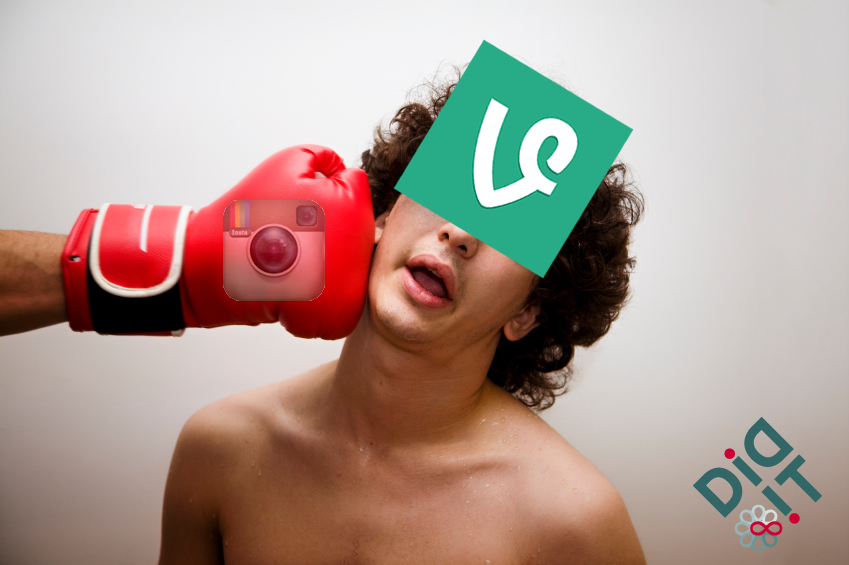One year later, Vine still isn’t dead — yet

June 16, 2014: Vine’s demise was a big question back in 2013 when video first came to Instagram. Hence my article on Didit.com predicting Vine’s imminent annihilation.
OK – I’m not a clairvoyant. Vine’s still around (the only thing that’s been annihilated are billions of hours of teenager’s TV watching time). What’s fascinating is that the competitive field is a lot more interesting than it was a year ago. There’ve been a spate of high-value acquisitions in the private messaging space, with the purchase of WhatsApp by Facebook in February for $16 billion, Chat App Viber by Rakuten for $900 million, and messaging startup Tango raising $280 million in March. Obviously, investors and VCs think messaging is hugely important. That’s why the stakes in this epic battle are only going one way: up.
![]()
VINE VS. INSTAGRAM REDUX
Vis a vis the original contest of Vine vs. Instagram, a clear winner is emerging. It’s clear that brands prefer Instagram over Vine for Twitter posts (interesting because back in 2013, when I predicted an end run by Facebook against Twitter, it was clear that hashtags would be a major factor in the contest).
How’s this for weird: it seems that Instagram’s ability to harmonize with Twitter’s hashtag functionality makes it a better Twitter add-on than Vine is. Supporting evidence exists over at www.socialbakers.com, which cites the fact that Instagram has better engagement rates than those of equivalent Vine videos.
But Vine is not giving up without a fight. Ted Rubin at Collective Bias shares the news that Vine has just rolled out a big app update that includes “revining” (think retweeting), vine genres and a redesigned camera. And the folks at Digiday have their own engagement metrics for Vine and Instagram, showing a higher rate for Vine.
So the battle’s hardly over.
GOOGLE PLUS AND SLINGSHOT
And then there’s Google Plus. Although the popularity-obsessed digital marketing herd likes to diss Plus, it’s actually a fearsome contender when you take a good look at it. For example, the Google launcher in Android allows full access to the entire suite of Google tools on one’s phone. YouTube integration means that G+ users can just as easily reach branded videos as Vine and Instagram users can. Techtimely tells us that there now about 21 Million Google Plus users, 8 million more users than Vine. Google is building a formidable messaging armada here, and it’s obvious that any brand that ignores Plus does so at its own peril. Nor has Facebook been quiet. It’s now firing back with Slingshot, a new viral video app that is set to compete with Snapchat. This app works by having users “sling” content to other users, with content not visible to your friends until you share your own.
So, what does all this for marketers who want to reach that elusive tween to teen demographic? Couple of things:
- Generational staggering will be an ongoing issue. Differing age demos prefer different software platforms, making it hard for marketers to intelligently allocate marketing resources. The good news is that if you know — with exactitude — the precise age demo you’re after, you can segment by platform.
- Cross-platform integration. Now that hashtags are ubiquitous, marketers can worry less about optimize campaigns for multiple platforms. Hashtags anchor campaigns across platforms that support them. Instead of obsessing about segmentation issues, they can focus on content — which matters a lot on mobile.
SO WHAT’S A MARKETER TO DO?
Being forced to configure campaigns for each messaging platform is a real pain that absorbs time, energy, and budget. As much as marketers wish there was one single platform they could just write content for and buy ads on, that’s not going to happen for a while.
The best way to deal with the situation is to:
- Examine the platform culture. Each platform has a different culture and vibe. A video that plays well on Vine might not do so well on Youtube. Look at what competitors are doing and look for opportunities in the communities on different platforms. Do your hashtag research.
- Customize content. Make sure that your content matches the brand image you want to project. on each platform. Vine and Instagram both have unique user cultures that may need to be approached in different ways.
- Test your assumptions. The only way to really know what message to put, where, and to whom is to put some money behind it. You’ll know pretty quickly which platform is most “resonant” for your messaging.
Have a question about content marketing or social media? Feel free to contact us or tweet us @DiditMarketing.
- 10 Mistakes to Avoid When Using QR Codes for Marketing - September 20, 2023
- Kevin Lee on How AI Changes the SEO Landscape - August 31, 2023
- The Power of Compound Marketing: Kevin Lee Presents @ 1MediaWorld 2023 Global Conference - March 7, 2023

